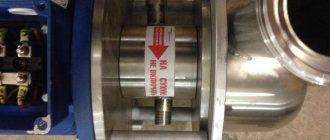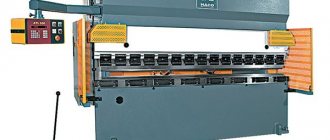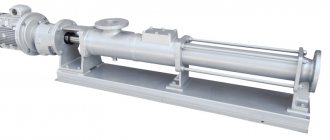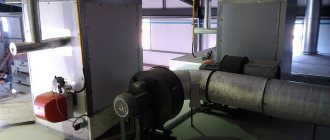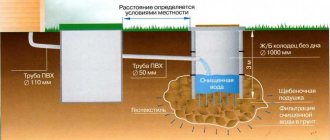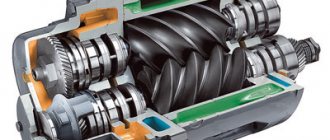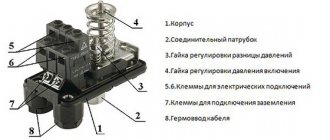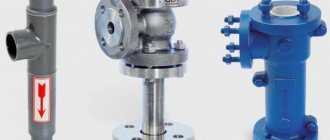With the development of the industrial sector, a large number of technological processes required forced air supply. The household sector has not been left out either. Some types of communications require a regular supply of fresh air.
An elegant solution to this problem was a centrifugal fan, which is capable of autonomously pumping the required amount of air mass. But how is it designed and how does it work? It is these questions that we will examine in detail in our article.
Let's consider the design features of the device, its capabilities, scope of application, and the best manufacturers whose products are presented on the market. We will also give recommendations on choosing the appropriate fan model.
The essence of pumping and rarefying air with a fan
A fan is a mechanical structure that is capable of processing the flow of a gas-air mixture by increasing its specific energy for subsequent movement.
This architecture of the unit makes it possible to create the effect of injection or rarefaction of the working gas in space through an increase or decrease in pressure, respectively (energy conversion mechanism).
Gas pressure is understood as an endless process of chaotic movement of gas molecules, which, hitting the walls of a closed space, create pressure on them.
Therefore, the higher the speed of these molecules, the more impacts and the higher the pressure. Gas pressure is one of the main characteristics of gas.
Image gallery
Photo from
The simplest type of fans
Fan installation in a manufacturing plant
Centrifugal fan motor
Types of radial fan units
On the other hand, any gas has two more parameters: volume and temperature. Volume is the amount of space filled by a gas. Gas temperature is a thermodynamic characteristic that relates the speed of molecules and the pressure they generate.
These “three pillars” are based on the molecular kinetic theory, which is the basis for describing all processes associated with the processing of gases and gas mixtures.
The injection process is a forced concentration of molecules in a confined space beyond a certain norm. For example, the generally accepted air pressure at the surface of the earth is approximately 100 kPa (105 kiloPascals) or 760 mmHg. Art. (millimeters of mercury).
As the altitude above the Earth's surface increases, the pressure decreases and the air becomes rarefied.
Atmospheric pressure is the weight of a column of air relative to the surface area over which it is located. Not mass, but weight P=mg. Measured by a barometer, other types of pressure are determined by a manometer
Rarefaction is the reverse process of pumping, during which molecules leave a closed system. The volume remains the same, but the number of molecules decreases significantly, therefore, the pressure decreases.
The pumping effect is necessary to force the movement of air. It is possible to move air through the rarefaction effect: to restore the pressure balance in the entire system, molecules move from a more concentrated area of molecules to a less concentrated one.
This is how gas molecules move.
To determine the speed of air flow outside or inside a building, a special tool is often used - an anemometer. An indispensable device for designing ventilation systems
There are a variety of ventilation system layouts, but they can be divided into several classes according to certain parameters:
- By appointment. There are general and special purpose fans. Fans are used for normal gas movement. Special fans are used for pneumatic transport, transportation of aggressive and explosive gas mixtures.
- In terms of speed . There are wheels with blades with low, medium and high specific rotation speeds.
- By pressure range. There are known systems for generating low (up to 1 kPa), medium (1–3 kPa), high (more than 3 kPa) pressure.
Some industrial and domestic processes using blowers occur in extreme environmental conditions, so the corresponding requirements are put forward for the equipment.
Thus, we can talk about dust-proof, moisture-proof, heat-resistant, corrosion-resistant, spark-proof units and smoke removal devices and conventional fans.
Information about the types of fans is discussed in detail in our other article.
Straight-through or bladeless models
A bladeless fan is a fairly new product in the class of household appliances. They are just exploring the domestic market. The operation of devices of this class is based on Bernoulli's law. Roughly speaking, fast-moving air currents in a carefully thought-out design not only initiate the movement of additional volumes, but also significantly increase the overall efficiency of ventilation.
The device consists of several functional parts.
- A frame, usually in the form of a circle or oval. Its design involves the simultaneous release of air masses from inside the fan housing and the intake of volume from the outside.
- A base that serves as the basis for attaching all components.
- Compact turbine.
- Engine.
The fan works quite simply. The turbine is driven by a motor. It sucks air through holes in the bottom of the device. At the same time, the turbine design creates significant turbulence. As a result, the air is accelerated up to 15 times. The accelerated gas is ejected through the slotted channels of the frame, bending around its surface. At the same time, moving at high speed, it creates a vacuum. This captures air flows from the outside, trying to fill the resulting low pressure zone.
This principle of fan operation has many advantages.
- The air flow can be continuously adjusted.
- All moving parts are hidden inside the housing, which means the device is safe to use.
- It is easy to adjust the airflow direction by simply changing the position of the ring.
- Energy consumption is reduced by up to 20% compared to classic models with equal performance.
We have listed the main types of fans that can be used for ventilation of industrial facilities, government agencies, restaurants and canteens, multi-story buildings in residential areas, which are mounted in inconspicuous places on the back side or on top of flat roof slabs. There are special devices of enormous power that are capable of reliably ventilating objects simultaneously through several air ducts, but this is a completely different topic.
Features of the device operating cycle
Let's look at the general operating principle of a centrifugal blower with a radial design. Note that experts distinguish between two main fan designs: with an axial and radial placement of the inlet into which the air flow is sucked.
This primarily affects the option of installing the fan in the system and has virtually no effect on the overall performance.
A radial fan can work both with ordinary air, which it takes from the space, and with flow air that goes through the air duct (the effect of balancing areas with different pressures)
The axial inlet is typical for general purpose positive displacement blowers. Radial placement of the flow inlet is typical for mainline blowers.
During the first stage of the fan operating cycle, air flow moves onto the surface of a rapidly rotating impeller. The impeller blades divide the air into small volumes that move inside the working chamber.
Here the air mass accumulates, that is, the air mass is directly compressed into a small volume.
The design of the unit body itself has its own characteristics.
The two most common hull shapes are known:
- rounded;
- spiral.
The rounded shape of the housing is typical for fans that move a huge amount of air in a short process time. And the spiral shape is inherent in fans, which additionally compress the air volume and generate medium and high pressure.
At the second stage, air is pumped into the working chamber. As is known, at a constant volume, with an increase in the total mass of gas molecules, the number of collisions of molecules increases, and therefore their speed increases. Consequently, the gas pressure also increases.
The shape and number of blades are of great importance. Without exception, all impeller options are tested in wind tunnels to determine optimal operating conditions
At the final stage, the compressed gas is removed from the working chamber to the outlet. Then the air passes into the central air duct and moves in the indicated direction.
The rarefaction process occurs exactly the opposite. Air is taken from an air duct or confined space where a rarefied area needs to be created and discharged into the environment or other confined space.
Straight-through or bladeless models
A bladeless fan is a fairly new product in the class of household appliances. They are just exploring the domestic market. The operation of devices of this class is based on Bernoulli's law. Roughly speaking, fast-moving air currents in a carefully thought-out design not only initiate the movement of additional volumes, but also significantly increase the overall efficiency of ventilation.
The device consists of several functional parts.
- A frame, usually in the form of a circle or oval. Its design involves the simultaneous release of air masses from inside the fan housing and the intake of volume from the outside.
- A base that serves as the basis for attaching all components.
- Compact turbine.
- Engine.
The fan works quite simply. The turbine is driven by a motor. It sucks air through holes in the bottom of the device. At the same time, the turbine design creates significant turbulence. As a result, the air is accelerated up to 15 times. The accelerated gas is ejected through the slotted channels of the frame, bending around its surface. At the same time, moving at high speed, it creates a vacuum. This captures air flows from the outside, trying to fill the resulting low pressure zone.
This principle of fan operation has many advantages.
- The air flow can be continuously adjusted.
- All moving parts are hidden inside the housing, which means the device is safe to use.
- It is easy to adjust the airflow direction by simply changing the position of the ring.
- Energy consumption is reduced by up to 20% compared to classic models with equal performance.
We have listed the main types of fans that can be used for ventilation of industrial facilities, government agencies, restaurants and canteens, multi-story buildings in residential areas, which are mounted in inconspicuous places on the back side or on top of flat roof slabs. There are special devices of enormous power that are capable of reliably ventilating objects simultaneously through several air ducts, but this is a completely different topic.
Source
Centrifugal Fan Specification
Compressor systems are characterized by a number of structural and dynamic differences that must be taken into account when selecting and implementing them into the ventilation system.
The specifications include:
- the design of the blower itself;
- engine's type;
- Control block;
- placement of the impeller and transmission of rotational motion from the motor;
- angle of location of the inlet and outlet pipes;
- the material from which the product parts are made, its dimensions and weight.
Experts also pay attention to the compliance of products with international standards: ISO/IEC and GOST standards, IP markings, ATEX directives, etc.
Dynamic features include technical parameters of the blower performance: generated pressure and pressure drop coefficient, speed and maximum flow temperature, shaft speed and sound pressure level, efficiency and engine power
Discharge pressure is the maximum value that the fan is capable of creating during operation in nominal mode.
Pv = Psv + Pdv,
Where: Pv – total pressure, Psv – static pressure, Pdv – dynamic pressure.
Differential coefficient - the difference between the input and generated pressure (bar).
Volumetric air flow is the amount of gas mixture that moves per unit of time (productivity). Usually calculated in m3/h for domestic manufacturers, liters/min for foreign ones.
Rotation frequency is the number of full revolutions of the impeller per unit time. Calculated in pcs/s or Hz. It must be remembered that the load level of the air fan should not exceed 75% of the maximum.
Working for a long time in overload mode with a high rotation speed, the fan overheats and can quickly fail. But this process can be controlled by managing it at your own discretion. What is the fan speed controller used for?
Sound pressure is the noise level from rotating parts and air friction between metal. Measured at a distance of 3 meters from the source when it is operating at maximum load. Noise must be taken into account when choosing a constantly running fan.
Most equipment is equipped with noise and background sound absorbers. Noise standards: no more than 50 dBa for domestic premises and no more than 75 dBa for industrial premises
One of the devices with a negligible noise level is a bladeless fan.
The fan efficiency is the product of the following three coefficients:
- losses in air flow;
- leaks through gaps in the structure;
- mechanical efficiency of the product.
For centrifugal fans, the overall efficiency is in the range from 0.7 to 0.85, for axial (channel) fans - no more than 0.95. When choosing a radial fan, it is necessary to take into account the safety factor of the electric motor of 1.2. That is, select the electric motor power 20% more than required.
The power of the fan motor is determined by the formula:
N = (Q*P)/(102*3600*efficiency),
Where: Q – productivity (volume air flow), P – generated pressure.
Selection of fan according to requirements
The process of selecting ventilation equipment for an industrial facility (workshop, hangar) is a rather interesting and intricate process that must be done by a specialist. Features of ventilation of industrial premises are discussed in detail here.
There are already ready-made solutions for ordinary apartments and private houses. In the general case (for a 2-3 room apartment) we have the following architecture of the ventilation system:
- ventilators are installed in living rooms, the number of which depends on the size of the premises and the number of residents;
- Exhaust diffusers are integrated in the kitchen and bathroom, plus air ducts are laid to the air handling unit.
A centrifugal fan includes a control unit, a filter system for air purification, an electric motor and the radial fan itself.
For the above ventilation system, wall-mounted fans of the CF series produced by Vents with a capacity of up to 120 m3/hour are suitable
The current market for ventilation equipment is represented by a wide range of foreign-made companies: Systemair, Soler&Palau, OSTBERG, Rosenberg, HELIOS, Maico, Ruck Ventilatoren GmbH, AeroStar, Blauberg, Elicent, Rhoss, Frapol, CMT CLIMA, HygroMatik GmbH, Winterwarm, Tecnair LV, AERIAL GmbH , MITA.
Products from these companies will be an excellent solution for ventilation problems of any scale.
Domestic brands Vents, Elkom, Domovent and Veza are not inferior to them in the quality of production and reliability of equipment. If you have any doubts about the accuracy of the calculations made or the choice of a specific model, we recommend contacting the support service of any of the companies.
If you are the owner of a private 1-2 storey building, industrial or commercial building of a similar area (restaurant, warehouse, canteen, cafe, office), when choosing equipment, you must take into account the volume of the premises, the air exchange rate, the length and cross-section of the main pipelines.
The tasks of ventilation and smoke removal can be easily handled by multi-zone blowers or roof fans of the KROM series from the Veza company, fans of the VN series from the Vents company and others
Be sure to pay attention to the additional functionality of centrifugal fans and the possibility of integration into a variety of air conditioning systems.
Thus, radial blowers can be equipped with auxiliary components:
- adjustable timers and interval switches, photo sensors and humidity detectors;
- speed controllers and status indicators;
- sensors for electric motor overload and lack of electrical power supply;
- spring vibration absorbers or rubber vibration isolators.
If the fan is placed inside an apartment or house, it can be covered with a removable front decorative panel made of aluminum or plastic, taking into account the interior of the room.
For many users, an important criterion when choosing a fan is the noise level. Are you looking for a quiet fan for your bathroom? We recommend that you familiarize yourself with the rating of silent fans.
